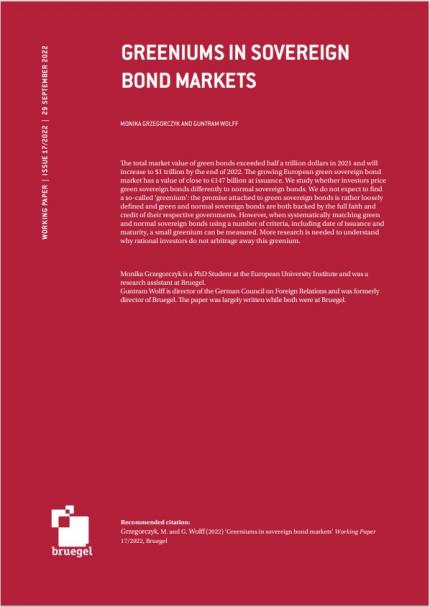You can download the complete PDF above.
Introduction
The total market value of green bonds exceeded half a trillion dollars in 2021 and will increase to $1 trillion by the end of 2022 according to the Climate Bond Initiative (CBI, 2022). Large parts of the market consist of private institutions issuing green bonds. More recently, international institutions and governments, as well as the European Union with its Next Generation EU programme, have issued substantial amounts of green bonds (OECD, 2021).
Research shows different yields for green and standard bonds, but the literature is inconclusive on whether there is a systematic positive or negative premium, or ‘greenium’, on green bonds (MacAskill et al, 2021)1. Most of the literature focuses on privately issued green bonds, while the emerging market of green sovereign bonds has been barely studied. A recent exception is the study by Bolton et al (2022), which is inconclusive and does not find a systemic greenium.
In principle, it is difficult to understand why a green bond issued by a sovereign should be priced differently to any other bond issued by the same sovereign. Green bonds, as currently issued by governments, involve a rather loose promise by governments that the proceeds from the bond sale will be used to fund specific green projects or green current expenditures. However, given the relatively small size of green bond issuance, of around 1.6 percent of total debt stock in the EU2, it is difficult to argue that these bonds fund projects that otherwise would not have been funded. Meanwhile, revenues in large public budgets are largely fungible. Moreover, none of the sovereign green bonds would result in penalty payments in case green promises are not kept. Instead, like a regular sovereign bond, the full faith and credit of the respective tax base stands behind the promise of repayment. For a rational marginal investor, possible price differences could thus be arbitraged away at a profit.
In this paper, we analyse whether green sovereign bonds are systematically priced differently to conventional sovereign bonds in the secondary markets. Almost no research has so far focused on the green sovereign bond market. The green bonds issued by the public and private sectors have the same fungibility and investor crowding. Yet, unlike private bonds, issuer prospectuses provided by national debt management agencies cannot tie the ultimate power of the legislature to defined expenditures (ie the green debt terms are by definition less credible).
The discount is not the only or primary motivation for green bond purchases. Domínguez-Jiménez and Lehmann (2021) suggested it may be “reputation building”. The value is represented by the capital raised through the issuance of green bonds since 2018, divided by total sovereign debt securities for the end of June 2022.
We are the first to document a systematically lower yield for green sovereign bonds. Unlike Bolton et al (2022), we have been able to match green bonds exactly with conventional sovereign bonds on all other characteristics and have identified ten exact matches. A possible explanation for this new empirical finding is the behavioural response of investors, which may be motivated by the reputational benefits of holding green bonds in their portfolios. Institutional investors may be a driver of this difference (Bachelet et al, 2019) but more research is needed on this.
We first review the literature, then describe the main characteristics of the European green sovereign bond market, before presenting our findings and conclusions.



